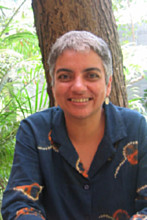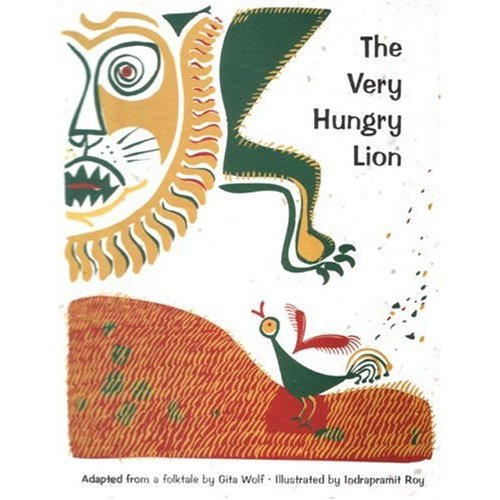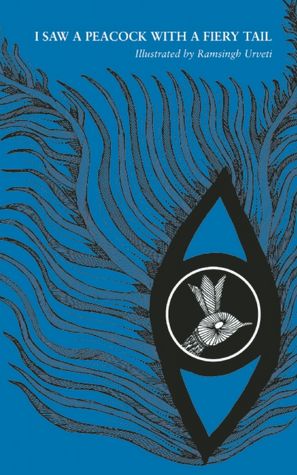 We caught up with Gita Wolf, founder of the Chennai, India-based publisher Tara Books, in New York a few weeks ago, while she was en route to the Guadalajara Book Fair.
We caught up with Gita Wolf, founder of the Chennai, India-based publisher Tara Books, in New York a few weeks ago, while she was en route to the Guadalajara Book Fair.
Attracted by the cover of the Tara Books catalog, a waiter in the Upper West Side coffee shop where we arranged to meet asked if he could look at it. The image that caught his eye came from the May 2012 title I Saw a Peacock with a Fiery Tail, based on a 17th-century poem and illustrated by Ramsingh Urveti in the traditional Gond style from central India. The art and craftmaking aspects of Tara Books certainly draw people's attention.
 This year, Tara Books celebrates its 15th anniversary; it published its first book, The Very Hungry Lion, written by Gita Wolf and illustrated by Indraprimit Roy, in 1996. Roy used the Warli style of painting from western India, and it was the publisher's first handmade book. It has sold more than 49,000 copies, each made by hand, one at a time. Wolf joked that she owes a debt to production manager C. Arumugam, whose mantra is, "Nothing is impossible." Also, nothing is wasted: the house recycles run-offs and misprints as "flukebooks," one-of-a-kind notebooks that retail for $11.99.
This year, Tara Books celebrates its 15th anniversary; it published its first book, The Very Hungry Lion, written by Gita Wolf and illustrated by Indraprimit Roy, in 1996. Roy used the Warli style of painting from western India, and it was the publisher's first handmade book. It has sold more than 49,000 copies, each made by hand, one at a time. Wolf joked that she owes a debt to production manager C. Arumugam, whose mantra is, "Nothing is impossible." Also, nothing is wasted: the house recycles run-offs and misprints as "flukebooks," one-of-a-kind notebooks that retail for $11.99.
 The Great Race, coming in June 2012, by Nathan Kumar Scott, is a hare-and-the-tortoise–style retelling of a popular Indonesian folktale featuring Kanchil the trickster mousedeer and Pelan the snail. Artist Jagdish Chitara makes his debut with this book, using the Mata-ni-Pachedi style of ritual textile painting from Gujarat, also in western India. Wolf explained that Chitara's "brush" is actually a sharpened twig, to get the fine outlines you see in the artwork. This is the first time this form of traditional art has been used to illustrate a story.
The Great Race, coming in June 2012, by Nathan Kumar Scott, is a hare-and-the-tortoise–style retelling of a popular Indonesian folktale featuring Kanchil the trickster mousedeer and Pelan the snail. Artist Jagdish Chitara makes his debut with this book, using the Mata-ni-Pachedi style of ritual textile painting from Gujarat, also in western India. Wolf explained that Chitara's "brush" is actually a sharpened twig, to get the fine outlines you see in the artwork. This is the first time this form of traditional art has been used to illustrate a story.
Tara Books titles have twice won the Bologna Ragazzi Award, in 2010 for Do! by Gita Wolf, illustrated by Ramesh Hengadi and Shantaram Dhadpe, and in 2008 for The Night Life of Trees by Bhajju Shyam, Durga Bai and R.S. Urveti. Wolf is on a mission to preserve the art of bookmaking. Together with her collective of writers, designers, artists and others, Wolf is establishing a Center for the Book Arts in Chennai. The center will house a gallery, a bookstore and work space for artists.
After the Guadalajara Book Fair, Wolf met with a team in Mexico that wants to create a collective modeled on Tara Books, and work with indigenous artists such as the Mayan community. Wolf acknowledges that the Internet is important for spreading the word about books. But it also plays a role in homogenizing the titles that come to market. Her approach, on the other hand, is all about the uniqueness of each book. "People are making publishing decisions who know nothing about bookmaking," Wolf said. "That's why independent publishers are so important." --Jennifer M. Brown






 In a follow-up to last week's
In a follow-up to last week's  Manjoo's suggestion was countered on Twitter and in the comments section, where
Manjoo's suggestion was countered on Twitter and in the comments section, where  In anticipation of all those "shiny new e-readers" people will be receiving as gifts this holiday season, BookPeople bookstore, Austin, Tex., has introduced an
In anticipation of all those "shiny new e-readers" people will be receiving as gifts this holiday season, BookPeople bookstore, Austin, Tex., has introduced an  Readers who want to keep their local community strong can take the "
Readers who want to keep their local community strong can take the " Shoppers using Google Chrome who would like a friendly reminder of their book-buying options can download the
Shoppers using Google Chrome who would like a friendly reminder of their book-buying options can download the  Renée Reiner and Michael DeSanto, co-owners of
Renée Reiner and Michael DeSanto, co-owners of  At the same time, Keith Terwillegar, owner of downtown Burlington indie
At the same time, Keith Terwillegar, owner of downtown Burlington indie  The opening of the
The opening of the  Earlier this month the Barnes & Noble in Roanoke, Va., hosted a signing for Animals and the Kids Who Love Them: Extraordinary True Stories of Hope, Healing, and Compassion (New World Library). During the event, story contributor and occupational therapist Mona Sams shared her story, "Missy's Magical Llamas," with one magical attendee.
Earlier this month the Barnes & Noble in Roanoke, Va., hosted a signing for Animals and the Kids Who Love Them: Extraordinary True Stories of Hope, Healing, and Compassion (New World Library). During the event, story contributor and occupational therapist Mona Sams shared her story, "Missy's Magical Llamas," with one magical attendee. We caught up with Gita Wolf, founder of the Chennai, India-based publisher
We caught up with Gita Wolf, founder of the Chennai, India-based publisher  This year, Tara Books celebrates its 15th anniversary; it published its first book, The Very Hungry Lion, written by Gita Wolf and illustrated by Indraprimit Roy, in 1996. Roy used the Warli style of painting from western India, and it was the publisher's first handmade book. It has sold more than 49,000 copies, each made by hand, one at a time. Wolf joked that she owes a debt to production manager C. Arumugam, whose mantra is, "Nothing is impossible." Also, nothing is wasted: the house recycles run-offs and misprints as "flukebooks," one-of-a-kind notebooks that retail for $11.99.
This year, Tara Books celebrates its 15th anniversary; it published its first book, The Very Hungry Lion, written by Gita Wolf and illustrated by Indraprimit Roy, in 1996. Roy used the Warli style of painting from western India, and it was the publisher's first handmade book. It has sold more than 49,000 copies, each made by hand, one at a time. Wolf joked that she owes a debt to production manager C. Arumugam, whose mantra is, "Nothing is impossible." Also, nothing is wasted: the house recycles run-offs and misprints as "flukebooks," one-of-a-kind notebooks that retail for $11.99. The Great Race, coming in June 2012, by Nathan Kumar Scott, is a hare-and-the-tortoise–style retelling of a popular Indonesian folktale featuring Kanchil the trickster mousedeer and Pelan the snail. Artist Jagdish Chitara makes his debut with this book, using the Mata-ni-Pachedi style of ritual textile painting from Gujarat, also in western India. Wolf explained that Chitara's "brush" is actually a sharpened twig, to get the fine outlines you see in the artwork. This is the first time this form of traditional art has been used to illustrate a story.
The Great Race, coming in June 2012, by Nathan Kumar Scott, is a hare-and-the-tortoise–style retelling of a popular Indonesian folktale featuring Kanchil the trickster mousedeer and Pelan the snail. Artist Jagdish Chitara makes his debut with this book, using the Mata-ni-Pachedi style of ritual textile painting from Gujarat, also in western India. Wolf explained that Chitara's "brush" is actually a sharpened twig, to get the fine outlines you see in the artwork. This is the first time this form of traditional art has been used to illustrate a story. Westwinds Bookshop
Westwinds Bookshop Does the barrage of holiday reading lists just add to your winter chills? The
Does the barrage of holiday reading lists just add to your winter chills? The  The Adventures of Tintin, based on the comic by Hergé, has opened. Steven Spielberg directs this animated tale starring Daniel Craig, Andy Serkis, Simon Pegg, Cary Elwes, Nick Frost and Jamie Bell.
The Adventures of Tintin, based on the comic by Hergé, has opened. Steven Spielberg directs this animated tale starring Daniel Craig, Andy Serkis, Simon Pegg, Cary Elwes, Nick Frost and Jamie Bell. War Horse, based on the book by Michael Morpurgo (Scholastic, $8.99, 9780545403351), opens on Christmas Day, December 25. A busy Steven Spielberg directs this story of a boy and his horse caught up in the horrors of World War I. Stars Tom Hiddleston, Benedict Cumberbatch and David Thewlis. The official companion book, War Horse: The Making of the Motion Picture (Newmarket Press for It Books, hardcover, $34.99, 9780062192615), has more than 140 dramatic images, commentary from the filmmakers, script excerpts and introductions by Spielberg, producer Kathleen Kennedy, Morpurgo and co-screenwriter Richard Curtis.
War Horse, based on the book by Michael Morpurgo (Scholastic, $8.99, 9780545403351), opens on Christmas Day, December 25. A busy Steven Spielberg directs this story of a boy and his horse caught up in the horrors of World War I. Stars Tom Hiddleston, Benedict Cumberbatch and David Thewlis. The official companion book, War Horse: The Making of the Motion Picture (Newmarket Press for It Books, hardcover, $34.99, 9780062192615), has more than 140 dramatic images, commentary from the filmmakers, script excerpts and introductions by Spielberg, producer Kathleen Kennedy, Morpurgo and co-screenwriter Richard Curtis.
 The
The  You don't have to read Yiddish to appreciate What We Talk About When We Talk About Anne Frank, the new story collection from Nathan Englander (For the Relief of Unbearable Urges), just as you don't have to read Spanish to understand the Hemingway novels set mostly in Spain--but it helps. While Englander's stories range across time and geography, his characters nearly all live under the cloud of the Shoah and the long Jewish history of migration, argument, suffering, survival... and always stories. The sprinkling of Yiddish terms and expressions throughout give the stories flavor and context, for, as a storytelling Jerusalem father explains to his son, "There is always context in life."
You don't have to read Yiddish to appreciate What We Talk About When We Talk About Anne Frank, the new story collection from Nathan Englander (For the Relief of Unbearable Urges), just as you don't have to read Spanish to understand the Hemingway novels set mostly in Spain--but it helps. While Englander's stories range across time and geography, his characters nearly all live under the cloud of the Shoah and the long Jewish history of migration, argument, suffering, survival... and always stories. The sprinkling of Yiddish terms and expressions throughout give the stories flavor and context, for, as a storytelling Jerusalem father explains to his son, "There is always context in life."
 We don't usually have a tree in our house, but I did consider making a Bookmas Tree for us. The best I could come up with during some outdoor beta testing, however, was a minimalist, hybrid version I dubbed "A Book & a Nook Tree," inspired no doubt by Charlie Brown's classic underachieving nevergreen.
We don't usually have a tree in our house, but I did consider making a Bookmas Tree for us. The best I could come up with during some outdoor beta testing, however, was a minimalist, hybrid version I dubbed "A Book & a Nook Tree," inspired no doubt by Charlie Brown's classic underachieving nevergreen.  That's Chase Duhon, a junior majoring in biology, standing in front of the Knowledge Center's Bookmas Tree, which is topped by an unusual, if apt, combo of the school's mascot Wolfie--in a tiny Santa Claus hat--and a Hawaiian-themed decoration. They earned this place of honor because the Nevada Wolf Pack football team will play Southern Miss in the Sheraton Hawai'i Bowl game on Christmas Eve (and Kamaunu is from Hawaii).
That's Chase Duhon, a junior majoring in biology, standing in front of the Knowledge Center's Bookmas Tree, which is topped by an unusual, if apt, combo of the school's mascot Wolfie--in a tiny Santa Claus hat--and a Hawaiian-themed decoration. They earned this place of honor because the Nevada Wolf Pack football team will play Southern Miss in the Sheraton Hawai'i Bowl game on Christmas Eve (and Kamaunu is from Hawaii).